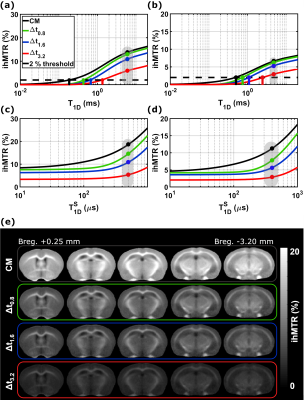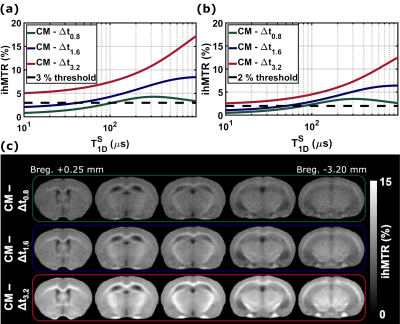Andreea Hertanu1,2, Lucas Soustelle1,2, Arnaud Le Troter1,2, Julie Buron1,2,3, Julie Le Priellec3, Victor N. D. Carvalho1,2,4, Myriam Cayre3, Pascale Durbec3, Gopal Varma5, David C. Alsop5, Olivier M. Girard1,2, and Guillaume Duhamel1,2
1Aix Marseille Univ, CNRS, CRMBM, Marseille, France, 2APHM, Hôpital Universitaire Timone, CEMEREM, Marseille, France, 3Aix Marseille Univ, CNRS, IBDM, Marseille, France, 4Aix Marseille Univ, CNRS, ICR, Marseille, France, 5Division of MR Research, Radiology, Beth Israel Deaconess Medical Center, Harvard Medical School, Boston, MA, United States
1Aix Marseille Univ, CNRS, CRMBM, Marseille, France, 2APHM, Hôpital Universitaire Timone, CEMEREM, Marseille, France, 3Aix Marseille Univ, CNRS, IBDM, Marseille, France, 4Aix Marseille Univ, CNRS, ICR, Marseille, France, 5Division of MR Research, Radiology, Beth Israel Deaconess Medical Center, Harvard Medical School, Boston, MA, United States
Filtering
the short T1D components contributing to the ihMT signal leads to an
increase in the experimental WM/GM relative contrast. A minimum of two T1D
components must be considered in the theoretical model to predict this
experimental observation.

Figure 3:
Simulated ihMTR(T1D) curves with various Δt values for (a, b) WM and
GM respectively, using the single-T1D model. The 2% line represents
the detectability threshold, arbitrarily chosen. (c, d) ihMTR(T1D)
simulated for WM and GM, using the bi-T1D model. The long T1D
component was fixed at 6.0 ms for WM and 5.8 ms for GM, and the short component
was varied in the [10 µs; 1 ms] range. (e) Experimental ihMTR templates corresponding
to different levels about the bregma.

Figure 4:
ihMTR(T1D) curves corresponding to the subtractions between the
non-filtered and the filtered configurations for (a) WM and (b) GM. Only CM-Δt0.8
was able to isolate a detectable signal within a finite range of T1D values
(100 µs - 1 ms). (c) Experimental subtracted ihMTR maps template at different
bregma levels.
